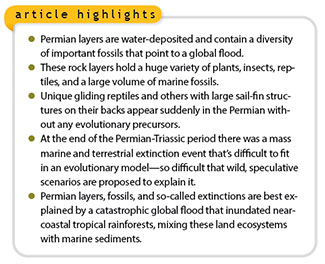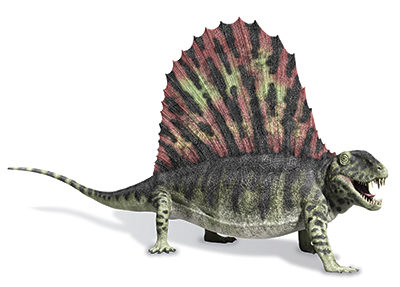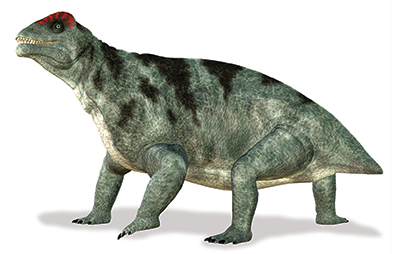 Permian rock layers contain several of the fossil record’s greatest evolutionary enigmas. These rocks are found directly above Carboniferous strata, which I explained in the previous two articles in this series.1-2 One enigma is the famous and hotly debated Permian-Triassic (P-T) mass extinction that included a dramatic shift in plant fossils, along with huge disappearances of marine life in the fossil record and, to a lesser degree, terrestrial creatures.
Permian rock layers contain several of the fossil record’s greatest evolutionary enigmas. These rocks are found directly above Carboniferous strata, which I explained in the previous two articles in this series.1-2 One enigma is the famous and hotly debated Permian-Triassic (P-T) mass extinction that included a dramatic shift in plant fossils, along with huge disappearances of marine life in the fossil record and, to a lesser degree, terrestrial creatures.
The other enigma is the sudden appearance of a whole host of extinct strange creatures that defy evolutionary explanation, along with others that are still alive today. However, these mysteries dissolve away when we place these plants and animals within a global Flood model of burial by ecological zonation.
Permian Rocks Are Flood-Formed

Land life buried in Permian sedimentary rock units include diverse plants, arthropods, and a huge diversity of highly specialized and unique reptile-like creatures that are no longer living today. Evolutionists have claimed that many of these creatures lived in a massive arid desert environment simply based on the fact that they were buried in sandstone, commonly a type of water-deposited sedimentary rock.
In fact, secular scientists have claimed that these deposits represent ancient wind-blown sand dunes despite the fact that it’s quite obvious they contain features that could only have formed by water. In recent years, extensive research has been completed on these rock units by analyzing sedimentary structures (cross-bedding) and microscopic thin sections, looking at sediment particles within the rocks and comparing these data to present-day sand dunes.3 The clear implication of these data is that Permian deposits were unequivocally formed in a massive catastrophic flood.
Plants and Living Fossils

Much of the plant life found buried in Permian strata overlaps with the Late Carboniferous (Pennsylvanian system) strata, such as the swamp-like large plants that grew as tall as 100 feet called Lepidodendron and Sigillaria.4-6 However, seed ferns and conifers also began to be buried in these Flood sediments since they would have been living slightly more inland from the coastal forests and swamp-like ocean shorelines representing the land fossils in the Carboniferous layers.
The various conifer plant groups were a diverse mix, and these ecosystems also included large trees like ginkgoes and cycads along with seed ferns. Not only are many types of cycads still with us today in rainforests near coastal regions but also ginkgoes, which not only appeared suddenly in the fossil record but look exactly like ginkgo trees growing around the world today. Thus, the beautiful ginkgo tree enjoyed by many gardeners and horticulturists is considered a living fossil that defies evolution. In addition, conifers found in Permian strata are very similar in appearance to current living counterparts and were as broadly adapted to diverse ecosystems as many conifers are today.
Insect Fossils Galore
Beginning in the Late Carboniferous layers and continuing through the Permian are many different types of insects such as dragonflies, numerous types of beetles (Coleoptera), true bugs (Hemiptera), and even grasshopper/cricket-like insects (Orthoptera).4-6 In fact, all of these major groups of insects (known as orders) appear suddenly in the fossil record without any evolutionary precursors and look similar to counterparts living among us today. But even more interesting is the fact that the Permian rocks contain a huge diversity and abundance of cockroach-like insects.
When we consider these types of fossils, it’s important to keep in mind that insects are extremely sophisticated creatures with a diversity of folding wing and flight systems, complex compound eyes, sophisticated antennas with amazing sensor systems, versatile digestive systems, spectacularly complex and efficient mouthparts, and rugged and versatile chitin-based exoskeletons. Not only do all of these land arthropod creatures appear suddenly and fully formed in these rock layers, but their traits would have made them ideally suited to life in the near-coastal tropical rainforest ecosystems represented by other Permian fossils.
Reptile Fossils
Reptile and reptile-like fossils tend to get the most attention when secular scientists discuss the Permian rocks because of their sudden appearance and spectacular traits.4-6 In fact, there are so many different types of reptile creatures whose fossils are found in these rock layers that it’s only possible to highlight a few of the most interesting.
One prominent group of creatures commonly found in Early Permian layers are the pelycosaurs, which included reptiles with spectacular sail-like structures on their backs that integrated with their spinal vertebrae and were thought to provide some sort of thermoregulatory function (edaphosaurids and sphenacodontids). Some of the more well-known members of these groups are Edaphosaurus, Dimetrodon, and Gordodon. Other diverse groups of reptiles without these unusual sails also existed, such as the diadectids.
Another amazing group of reptiles found in Permian layers had wing-like structures that allowed them to glide through the air—perhaps jumping out of trees as the Draco flying (gliding) lizard does, which is alive today and commonly observed in the forests of South Asia. One striking example of a flying lizard from Permian rocks is Coelurosauravus, which had a gliding mechanism unlike that of any other known tetrapod. The lateral gliding membrane featured bony rods independent of the ribcage and arranged to form a wing-like structure. And of course, none of these animals have any identified ancestors in rock layers below the Permian level.
Mammal-Like Reptiles?

Also appearing in the Permian rocks are what evolutionists have claimed were the first cynodonts. These were reptile-like creatures called therapsids that secular scientists imagine somehow evolved into the first mammals later in the Triassic, such as the oft-cited example of Moschops. While evolutionists originally widely used the term mammal-like reptiles, this phrase caused much consternation among paleontologists and those trying to sort out taxonomic groupings over the years.
Now they are referred to by secular scientists as stem mammals or proto-mammals, but these terms are also tainted with evolutionary fiction. The fact of the matter is that while these animals had some unusual teeth, skull structures, and more vertically placed legs than typical lizards, they were clearly reptile-like creatures. Despite the claims of evolutionists, there’s little evidence for this unique group of reptiles to support an evolutionary story of a transition from a reptile to a mammal.
Permian-Triassic Extinction Event
According to the evolutionary story, the end of the Permian was marked by the most extensive extinction event in the rock record, termed the P-T extinction.4-6 It’s claimed that approximately 90% of marine species went extinct, along with about 70% of all land species, including a mass extinction of insects. Trilobites, common marine arthropod creatures found in earlier strata down into the Cambrian, went fully extinct about this time. And other marine creatures found in the Permian—like nautiloids, brachiopods, and bryozoans (sedentary filter-feeding animals), clams and gastropods, and other ocean creatures—nearly disappeared, albeit a few species survived to the present with much less diversity than existed in the pre-Flood oceans.
One of the main problems evolutionists have in interpreting the P-T extinction event is that the timing of its specific details is very convoluted and drawn out (in evolutionary deep-time thinking). Many now-extinct Permian marine creatures were abundant right up to the close of the Permian deposition but, as mentioned above, land life was less represented in the extinction—especially land plants, which supposedly had a more extended extinction carrying on into the Triassic layers above. In other words, why the more sudden and more extensive marine extinction compared to the more spread-out land extinction? And why is the timing different between land animals, land plants, and marine creatures regarding the extinction?
Another problem secular scientists have with the P-T extinction is the progressive nature of the event based on conflicting and variable fossils assigned to various Permian deposits around the world. In fact, a number of scientists have claimed there were multiple extinctions over millions of years throughout the Permian leading up to the big one at the end.
Needless to say, this evolutionarily convoluted and extended so-called mass extinction is very difficult to explain when you want to add millions of years to the mix. Alleged mechanisms for it have varied between diverse hypotheses incorporating multiple meteor strikes, volcanic activity, ocean chemistry changes, global cooling, and even intense radiation from a nearby supernova. In fact, at this point many evolutionists now argue that the big P-T extinction was caused by a combination of some or all of the hypotheses listed above.
Explaining the Permian Perplexities with the Global Flood
One of the main mechanisms for the global Flood involved the progressive creation of hot and buoyant seafloor.7 This pushed the ocean level up higher and higher, causing the progressive inundation of land by ocean water and marine sediments. Permian deposits are rich in marine creatures that would have been found in shallow, tropical seas. For example, fossilized shells of two kinds of invertebrates are widely used to identify and correlate Permian strata: fusulinids, a kind of shelled amoeba-like protist (a foraminiferan); and ammonoids (cephalopods with shells) that share features with the living chambered nautilus today. These diagnostic creatures, along with others entombed with them, indicate and validate the progressive and global nature of the Genesis Flood. Thus, Permian strata represent the increasing perturbation of the offshore ocean ecosystems along with the progressive burying of higher-elevation land environments just above the coastal forests and swamps represented in the Carboniferous strata.
In the global Flood model of progressively laying down global megasequences, the Permian level falls within the early Absaroka Megasequence.7 This makes perfect sense since the Absaroka also begins with the Late Carboniferous sediments, which have extensive overlap with the Early Permian in regard to the types of plants and animals that are entombed within it. Thus, we can clearly see the progressive burial of land-based ecosystems starting at the interior edge of the lycopod coastal forests and swamps found in Carboniferous strata and extending into the higher-elevation, near-coastal tropical rainforests found in Permian strata. As we look higher in the Permian strata, we see fossils representing progressively higher elevations and leading into layers where the Permian terminates the Paleozoic.
According to this Genesis Flood model, the pre-Flood mega-continent of Pangaea would still have been largely intact at this stage—a global geological configuration that even the secular world affirms for the Permian. However, because evolutionists fail to acknowledge the authenticity of the Genesis Flood account, their model makes little sense and, as we have seen, is full of discrepancies.
When we integrate paleontology with the geology of the global Flood, the data fit together quite nicely. There was no real extinction marking the P-T, only last appearances of many types of flora and fauna due to the progressive nature of the Flood as it inundated different ecosystems.
Click here for other articles in The Fossils Still Say No series.
References
- Tomkins, J. P. 2021. The Fossils Still Say No: Missing Early Evolution of Land Vertebrates. Acts & Facts. 50 (4): 10-12.
- Tomkins, J. P. 2021. The Fossils Still Say No: Enigma of the Carboniferous Explosion. Acts & Facts. 50 (5): 11-13.
- Whitmore, J. H. and P. A. Garner. 2018. The Coconino Sandstone (Permian, Arizona, USA): Implications for the origin of ancient cross-bedded sandstones. In Proceedings of the Eighth International Conference on Creationism. J. H. Whitmore, ed. Pittsburgh, PA: Creation Science Fellowship, 581-627.
- Prothero, D. R. and R. H. Dott. 2009. Evolution of the Earth, 8th ed. New York: McGraw-Hill Higher Education.
- Benton, M. J. 2015. Vertebrate Paleontology. West Sussex, UK: John Wiley & Sons Ltd.
- Wicander, R. and J. S. Monroe. 2016. Historical Geology: Evolution of Earth and Life Through Time, 8th ed. Boston, MA: Cengage Learning.
- Clarey, T. 2020. Carved in Stone: Geological Evidence of the Worldwide Flood. Dallas, TX: Institute for Creation Research, 234-255.
* Dr. Tomkins is Director of Research at the Institute for Creation Research and earned his Ph.D. in genetics from Clemson University.














